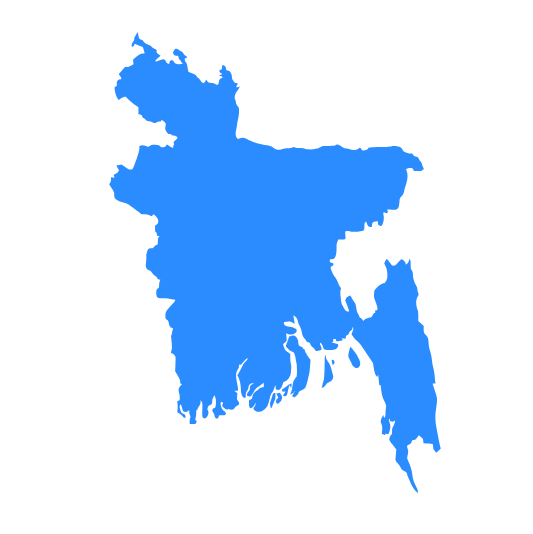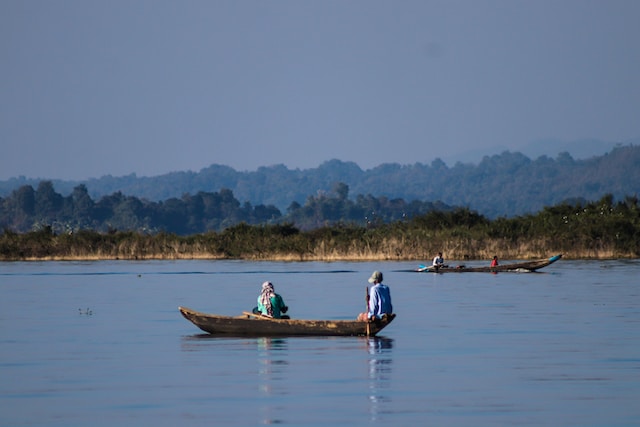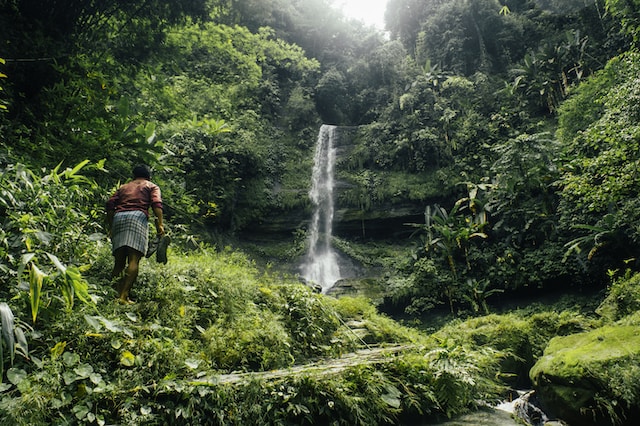It is Friday and the first day of the weekend in this largely Muslim country. Today there will be a big demonstration against the government in the centre of,Rajshani, a city of 1.5 million. The government are trying to make it hard for people to attend so it has stopped all the buses from running. As we leave we pass through several police checkpoints where they are looking at all the vehicles entering the city; perhaps this isn't as free a society as it appears.
We stop by a field where farm workers are harvesting rice. The paddy fields are dry and the rice golden with the seed heads hanging heavy on brown stems. Each day the workers cut as much they can and leave it laying in small sheaves to dry in the sun for a day before they take it to the village rice mill. Farmers get an amazing three rice crops a year, although 60% of the rice is harvested in the spring crop. Despite growing all this rice, Bangladesh still has to import more as it has over 165 million mouths to feed.
Later we visit a rice mill, really a
rice processing plant. The rice is cleaned then soaked for five days, steamed, dried, husked and polished. A 40 kg bag's wholesale price is just £8. An attractive price but we have a 20 kg baggage limit, we explain.
Lunch today is in a Bangla home. The lady of the house and her teenage son have cooked a wonderful spread of food: spinach, aubergine, roasted sliced potatoes, curried mixed vegetables, curried chicken, two kinds of spiced mashed potato and, of course, rice. All this was followed by rice pudding, made with date sugar and a pinch of cinnamon to make it a nice brown colour. It was a great meal.
Later in the day we visit a pottery village. All the 70 households make pots as a cooperative venture, with 20 village kilns. They dig the clay from the riverbed then puddle it with their feet for two days before making the pots with basic tools: wooden formers, large flat pestles and shells to make decorative rings. The pots and lids are laid in the sun to dry for a week before being fired in one of their wood fired kilns for two days;
in the monsoon the rains mean they can do no work.
Previously we had assumed that all villages were primarily farming but, from visiting the pottery village, this clearly isn't so. Later we visit a cluster of weavers' villages where they weave in an extraordinary way. The wefts are attached to a bar on a wall and then the weaver sits on the floor and stretches the wefts into their lap, effectively making a loom in mid-air. They then throw the shuttle across, using very thin thread. Very odd but it seemed to work; the fabric being produced was fine and beautiful.
We also see silk production - from caterpillar to scarf, salt production - a bit messy - and we visit the fish market - unbelievably messy. There are fish everywhere, fresh and flapping, in buckets, tanks and baskets together with a lot of water, hurrying porters, loaded tuk-tuks, loud buyers and sellers and us getting in the way. The market is huge and is held every morning for 9 months of every year; fishing is banned for the other three month to allow the fish to breed.
A small
fishing boat takes us on a trip around Chittagong bay to see the ship breakers at work. Giant ocean-going tankers are driven, nose first onto the beach and then taken apart. Everything that makes up a ship is removed and recycled; the hulls are cut up into huge sections which are then cut down into smaller pieces to be transported to steel smelters. It is recycling at its most extreme. The half-eaten carcasses of these once mighty ships make a sad sight; only the tiny people working on the boats brings any sense of scale to the scene
Then off to the Chittagong Hill Tracts; hills are a novelty in this flat land. The tracts are a troubled region of Bangladesh and we have 'Special Permits' to enter the area and we have a sheaf of paperwork ready as we approach the Tourist Police checkpoint. There are quite a lot of Tourist Police but very few tourists; we've met one other western tourist in the whole trip. So far the Tourist Police want only one thing from us, a photograph. We have to stand with them, smile and they add yet another photo to their Facebook page.
But getting our 'Special Permits' checked is likely to be a bit more tricky.
We stand outside their checkpoint,like children sent to the headmaster's office, before they order us back to wait on the bus. Then we have to hand in our passports and then we wait some more. After a while we are told to get off the bus again. Why? Because they want us to stand with them for a photograph, of course! We pass through about eight more checkpoints but luckily we only have to pose for two more photographs.
The Hill Tracts area is beautiful and we take a boat trip around a huge man-made lake, skirting the islands to visit villages and temples. The lake's water level has dropped two metres now that the monsoon season is over, enabling villagers to grow rice on the uncovered land around the shore.
This is a religiously diverse area with Hindus, Buddhist and Christians as well as Muslims; there does not seem to be any tension between the faiths and we see children of all faiths going to the same schools. We do notice that the facial features of
the local people are different to those in the rest of Bangladesh; the people in The Hill Tracts look more like those from Myanmar or Thailand. Indeed the scenery, too, reminds us of parts of Myanmar. The British, of course, drew up the borders, not the local people.
Small but populous Bangladesh is little known to most and is largely overshadowed by its neighbours. It has been a tough and interesting trip and we've seen a lot and met many very friendly Bangla people. We've talked about cricket (Bangladesh beat India yesterday) and football (flags wave for Brazil mainly, with a few for Argentina and odd German flags too) and posed for many selfies. It feels like a country on the way up … but there is yet another mass demonstration against the government planned for Saturday which has meant we are now staying on the edge of Dhaka rather than in the city.





